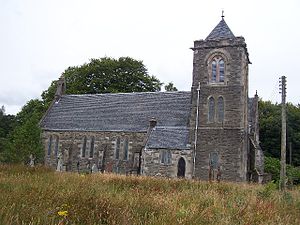Holy Trinity Church, Dunoon
Holy Trinity Church is an Episcopalian church building in Dunoon, Argyll and Bute, Scotland. It is located on Kilbride Road, southwest of the town centre. Constructed in the Gothic revival style, it is a Category B listed building.[2]
| Holy Trinity Church | |
|---|---|
 The church in 2005 | |

| |
| Location | Dunoon, Argyll and Bute |
| Country | Scotland, United Kingdom |
| Denomination | Episcopal |
| Website | Official website |
| History | |
| Status | open |
| Consecrated | 11 September 1850 |
| Architecture | |
| Functional status | used |
| Heritage designation | Category B listed building |
| Designated | 20 July 1971 |
| Architect(s) | John Henderson |
| Architectural type | Gothic revival |
| Groundbreaking | 1849 |
| Completed | 1850 |
| Clergy | |
| Rector | Revd. David Railton[1] |
The church was built in 1850 by John Henderson. It was extended to the west in 1896 by Alexander Ross. Its bell was cast by John Warner & Sons.[2]
History
In 1846, Revd. Henry George Pirie[3] began holding services for the Scottish Episcopalians of the town and district in a hall in the town centre. They began to raise funds for their own church building. One of the donors was William Gladstone, future British Prime Minister.[4]
The following year, after the granting of a site near the ancient Celtic St Bride well, a church design was commissions from Edinburgh architect John Henderson. The first stone of the church was laid under the alter on 31 March, 1849. Blessed by the Right Revd. Alexander Ewing, the new Bishop of Argyll, Holy Trinity was consecrated and opened for worship "according to the rites and ceremonies of the Scottish Episcopal Church" on 11 September, 1850.[4]
By the 1890s, the church was deemed too small for its summer congregation. In 1894, architect Alexander Ross, of Inverness, was asked to draw up plans to extend the church. The result was the nave being increased in size to the west by almost a third. A large western porch (narthex) and the tower and bells were added over the following few years.[4]
Electric heating and lighting were installed in the mid to late 20th century. The lighting was partly paid for and installed, for Christmas 1944, by the naval personnel stationed on HMS Curlew, the Clyde submarine defence base in Innellan.[4]
Stained glass was added over the years, and a new pipe organ was bought in 1882. This was replaced by an electric organ in the late 20th century. The church's sanctuary was remodelled around 1950.[4]
A major conservation project was undertaken in 2013, largely funded by the Heritage Lottery and Historic Scotland.[4]
Rectors
Holy Trinity Church has had over twenty rectors in its history.[4]
Graveyard
There are monuments to Alexander Reid, a notable figure in the history of Scottish art, and Sir Francis Powell, the Scottish watercolourist.[4][5]
See also
References
- Contacts - Holy Trinity Church official website
- HOLY TRINITY CHURCH, KILBRIDE HILL (EPISCOPAL) - Historic Environment Scotland
- The Episcopal Church of Scotland Proved to be in Full Communion with the Church of England, from Her Articles and Canons, and from the Testimony of English Archbishops and Bishops. By a Vicar of the Church of England (Joseph Bosworth, 1849)
- Our History - Holy Trinity Church official website
- Francis Powell - ArtofthePrint.com